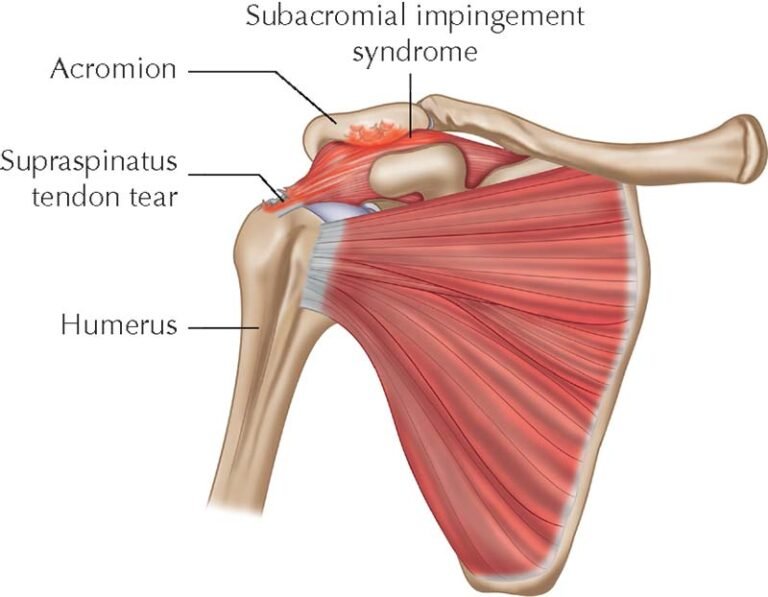Shoulder Pain
Supraspinatus Tendinitis: Causes, Symptoms, and Treatment

Recent Posts
Tags
Tags

written by/ Dr.Rana Shehata
“having a shoulder pain and you hear all the time that you have supraspinatus tendon inflammation, does this sound familiar?”
CONTINUE READING TO KNOW WHY!
Shoulder pain is a common complaint that can significantly affect daily life. One of the often-overlooked causes of shoulder discomfort is supraspinatus tendinitis. In this article, we’ll explore what supraspinatus tendinitis is, its causes, symptoms, and how it can be effectively treated.
What is Supraspinatus Tendinitis?
The supraspinatus is one of the four rotator cuff muscles in the shoulder. It plays a crucial role in helping you lift your arm and stabilize your shoulder joint. When the tendon connecting this muscle to the shoulder bone becomes inflamed or irritated, it leads to a condition known as supraspinatus tendinitis. This condition can cause pain, limited mobility, and difficulty performing everyday activities.


Causes of Supraspinatus Tendinitis
Several factors can contribute to the development of supraspinatus tendinitis:
The Main Cause
It happens mostly due to impingement as the tendon passes between the Acromion of the scapula and the humerus head.
So, any scapular-dyskinesias, dysfunction, or mal-alignment may lead to impingement pressuring the supraspinatus tendon causing its inflammation: if not treated, after time and overuse the inflammation progresses to a chronic phase accompanying sub-deltoid bursitis as well, Causing referred side shoulder pain down to the arms.
Then Chronic tendon inflammation is now present with scapular bone dysfunction; which may develop into partial tears with time.
⊕ There are several types of impingement
Definition of impingement: decrease in the space between two bones pressuring tendon or soft tissue on between
Impingement types:
- superior impingement: downward slopping of Acromion, scapula glided downward in resting position.
- Lateral superior impingement: lateral slopping of acromion, scapula mal-aligned in downward rotation in resting position.
- anterio-post impingement: scapula mal-aligned in Anterior tipping.
- scapular kyniseas dysfunction: imbalance in speed of scapulo-humeral Rhythm in Active movement
- thickening of tendons
And much more to discuss in upcoming articles…
Other Causes
- Overuse of Shoulder and Arm: Repetitive overhead activities, such as swimming, painting, or playing certain sports, can stress the tendon over time.
- Age: As we age, tendons can lose elasticity and become more susceptible to injury.
- Poor Posture: Slouching or other poor postural habits can place undue stress on the shoulder joint.
- Injury: A fall or accident can lead to immediate inflammation of the supraspinatus tendon.
- Underlying Conditions: Conditions such as arthritis, tendon thickening, and formation of classifications, all can also increase the risk of developing tendinitis.
“Supraspinatus tendinitis is a common source of pain in athletes who participate in overhead sports.”
Symptoms of Supraspinatus Tendinitis
Common symptoms include:
– Shoulder Pain: Pain is usually felt on the outer side of the shoulder and cause a referred pain in deltoid muscle down to the side of the arm.
pain in moving arm above head, it often worsens with overhead activities.
pain in side opening arm 60-120degree (Abduction)
– Limited Range of Motion: You may experience stiffness, making it difficult to lift your arm.
– Weakness: You might notice weakness when trying to lift or reach.
– Night Pain: Pain may be worse at night, making it hard to sleep.
Diagnosis
If you’re experiencing shoulder pain, it’s essential to consult a physiotherapist. A thorough physical examination, along with imaging tests such as X-rays or an MRI, may be necessary to confirm the diagnosis of supraspinatus tendinitis.
Treatment Options
The treatment for supraspinatus tendinitis typically involves a combination of the following approaches:
- Rest: Avoiding activities that aggravate the pain is crucial for recovery.
- Ice Therapy: Applying ice to the shoulder can help reduce inflammation and alleviate pain.
- Physiotherapy: a physiotherapist can design a tailored protocol to re-gain the biomechanics function, improve mobility, scapulo-humeral rhythm, scapular kyniseas, and joint dynamic stability by improving strength and flexibility of the shoulder muscles and rotator cuff.
- Medications: Nonsteroidal anti-inflammatory drugs (NSAIDs) can help manage pain and reduce inflammation.
- Injections: Corticosteroid injections may be recommended for severe pain.
- Surgery: In rare cases, if conservative treatments fail, surgery may be necessary to repair the damaged tendon.
Prevention Tips
- Strengthen Shoulder Muscles: Regularly perform exercises that strengthen the rotator cuff.
- Maintain Good Posture: Be mindful of your posture, especially during prolonged activities.
- Warm Up: Always warm up before engaging in sports or physical activities.
- Take Breaks: If your activities involve repetitive overhead movements, take regular breaks to rest your shoulder.
Conclusion
Supraspinatus tendinitis is a common source of shoulder pain that can hinder your daily activities. By understanding its causes, recognizing the symptoms, and seeking appropriate treatment, you can manage this condition effectively. If you’re experiencing shoulder pain, don’t hesitate to consult a specialized physiotherapist for a personalized assessment and treatment plan. Remember, taking proactive steps can help keep your shoulders healthy and pain-free!









